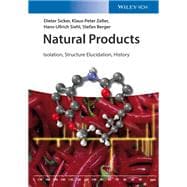
Note: Supplemental materials are not guaranteed with Rental or Used book purchases.
Purchase Benefits
What is included with this book?
Preface 3
Chapter 1. Alkaloids 9
1.1 Pseudopelletierine From the root-bark of the pomegranate tree 9
1.2 Colchicine From the seeds of the autumn crocus 29
1.3 Capsaicin From Kenyan "African Bird’s Eye Chilies" 49
Chapter 2. Coloured Compounds 69
2.1 Thymoquinone From the oil of the seeds of black caraway 69
2.2 Berberine Chloride From the bark of the common barberry 89
2.3 Carminic acid From dried cochineal 109
2.4 Safflomin A From flowers of the safflower 129
2.5 Chlorophyll a From deep frozen spinach leaves 151
Chapter 3. Carbohydrates and Glycosides 175
3.1 Raffinose From the seeds of blue lupins 175
3.2 Fraxin From the shredded bark of the ash tree 195
3.3 Stevioside From the dried leaves of Stevia rebaudiana 215
Chapter 4. Terpenoids 235
4.1 Linalool From Brazilian rosewood oil 235
4.2 Camphor From camphor tree oil 255
4.3 Cantharidin From Spanish fly Lytta vesicatoria 275
4.4 Artemisinin From the dried leaves of the annual mugwort 291
4.5 Diosgenin From an extract of the roots of Mexican yams 311
4.6 Friedelin From cork from the bark of the cork-oak 331
4.7 Boswellic acid From frankincense, the resin of the Arabian olibanum tree 353
Chapter 5. Aromatic Compounds 375
5.1 Sinensetin From cold-pressed orange oil 375
5.2 Rosmarinic acid From the dried leaves of lemon balm 391
Chapter 6. Quantum Chemical Calculation 411
Appendix 417
Spectroscopic Experiments 417
External Photographic Credits 418
Text Credits 419
Chemical Substance Index 421
General Subject Index 424
Name Index 432
The New copy of this book will include any supplemental materials advertised. Please check the title of the book to determine if it should include any access cards, study guides, lab manuals, CDs, etc.
The Used, Rental and eBook copies of this book are not guaranteed to include any supplemental materials. Typically, only the book itself is included. This is true even if the title states it includes any access cards, study guides, lab manuals, CDs, etc.